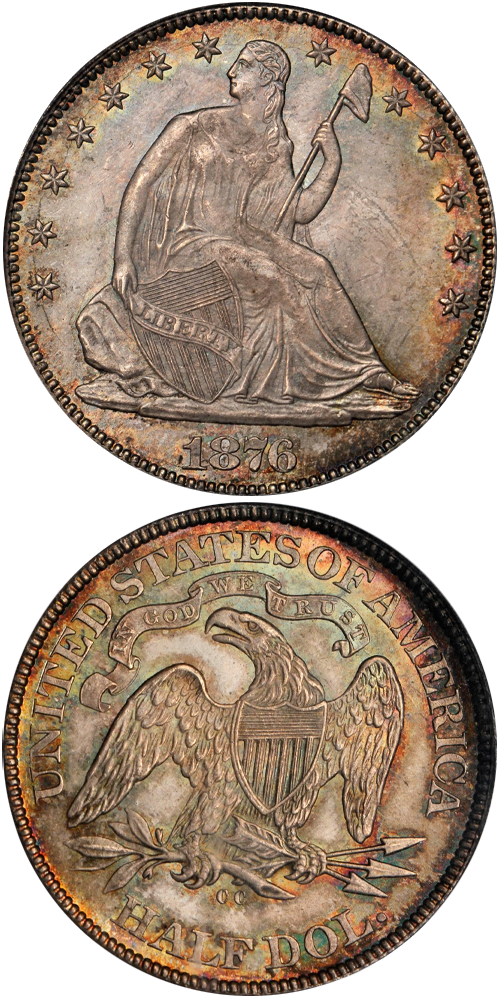1876-CC Liberty Seated Half Dollar
Jeff Ambio: The WB-19 marriage represents the only use of these dies in production of 1876-CC half dollars. A series of die lines within the recessed areas of the vertical shield stripes and extending into the rock to the left of the shield serve to identify the obverse die. On the reverse, several horizontal die lines are evident in the recessed area to the left of the uppermost arrow feather. Both dies are cracked around the peripheries, more extensively so on the obverse.
Rusty Goe: The Carson Mint more than doubled its quantity of coins delivered in 1876 from its per-piece count the previous year. Consequently, half dollar production soared to the highest level recorded between 1870 and 1878. Two other silver denominations, dimes and quarters, also registered record yields that year, as did gold double eagles.
The minters in Carson City knew that the enormous quantities of silver coins coming off their presses would not stay in Nevada. Instead, the government placed orders for this "small change" under provision of the Specie Resumption Act. The great majority of Carson City coins made in this era would end up practically everywhere except Nevada.
Dodging accusations of it turning out debased trade dollars and threats that the government planned to cut its appropriations drastically, the Carson Mint continued to produce record quantities of coins in every month of 1876. By August 8, the Carson Appeal showed that work had resumed in the second half of the year where it had left off at the annual cleanup time. "Superintendent Crawford hopes to make as much as $400,000 of subsidiary coin during the present month," stated the Appeal, which would represent a $60,000 increase over May's results. "For its inches our little mint discounts the world," it boasted.
Crawford's estimate proved to be too conservative. His staff of 90 workers turned out $505,625 in dimes, quarters, and half dollars in August. The 416,000 half dollars, ($208,000 in face value) set the high-water monthly mark for that denomination in 1876. By January 1, 1877, everyone involved in that record-setting year looked back with awe and appreciation for what they had accomplished at the Mint on Carson Street in 1876.
Q. David Bowers: The 1876-CC half dollar challenged the two million mark, an all-time record and one that would not be broken afterward. As might be expected, the result today is that examples are readily obtainable, with 200 to 300 estimated in Mint State, slightly more than that in EF to AU grade, and several thousand in all grades combined. Even though Mint State pieces come to the market frequently, there is something to be said for cherrypicking for quality. Rusty Goe surmises that to celebrate the centennial of American independence the Carson City coiners produced some with prooflike surfaces. Whatever the reason, coins with such reflectivity do exist. Further, within the date and mint the mintmark CC occurs in three distinct letter sizes, small, medium, and large. There is no particular premium for any of these, and it might be an interesting pursuit to try to get one of each.
In this year for the first time there were variations in the edge reed count, including 144, 152, 153, and 154. Wiley and Bugert identified 24 different die combinations resulting from 19 obverse dies and 21 reverses. Likely others exist.
The example to the left was sold by Stack's Bowers Galleries in the August 2012 Battle Born Collection of Carson City Coinage, where it realized $18,800.






